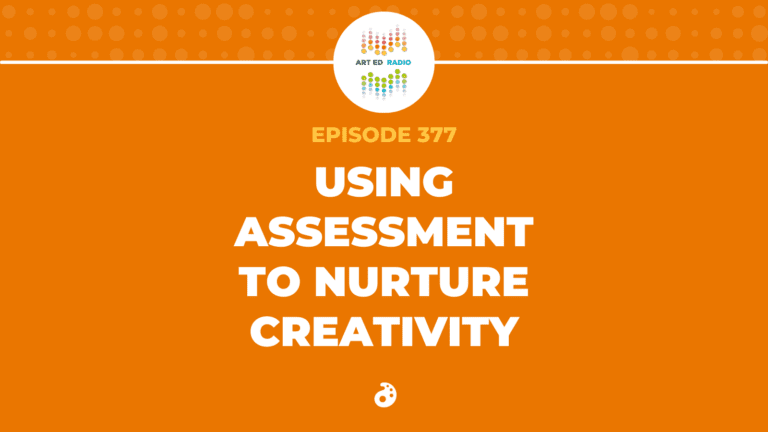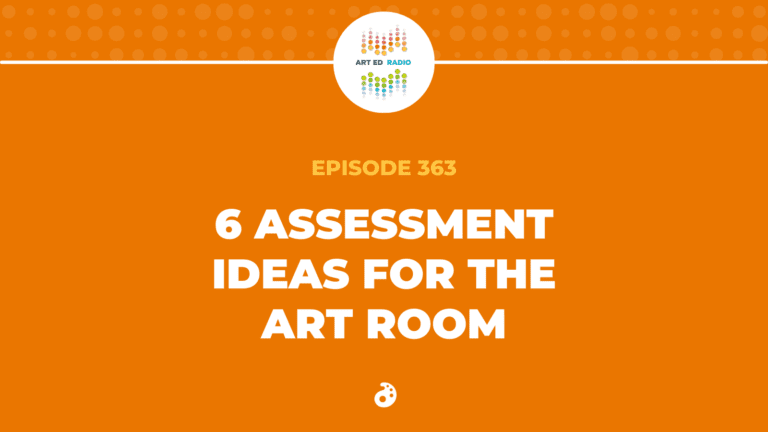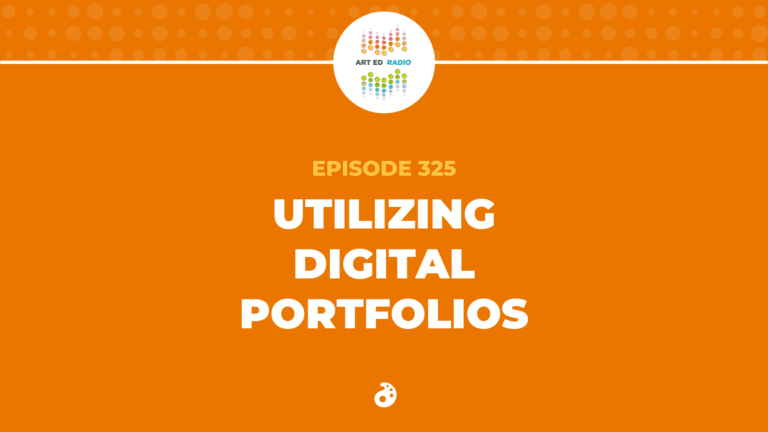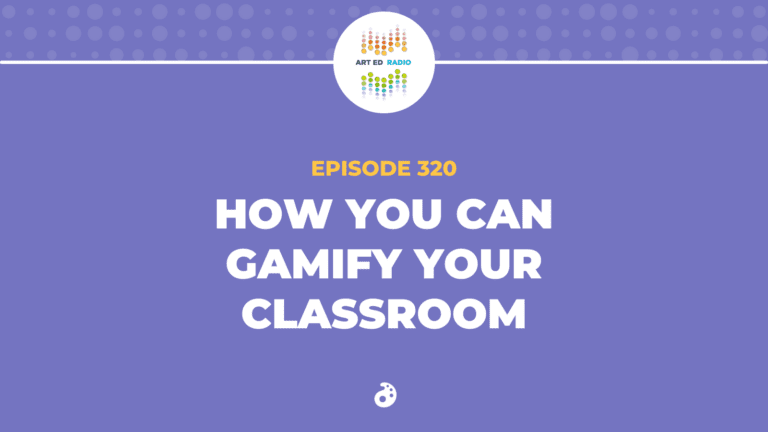After last week’s conversation on ending the year with favorite teacher portraits, Tim shares some ideas on how to create a meaningful artmaking project within the constraints of a finals schedule. Listen as he discusses how to work with themes on a final, everything involved in the planning process, and how students can find success with an end-of-year assessment. Full Episode Transcript Below.
Resources and Links
- Read Tim’s article on using final exam time for artmaking
- Listen to previous episodes: Lindsey Moss, Eric Scott, and Jessica Provow
- Check out The Art of SEL podcast from AOEU
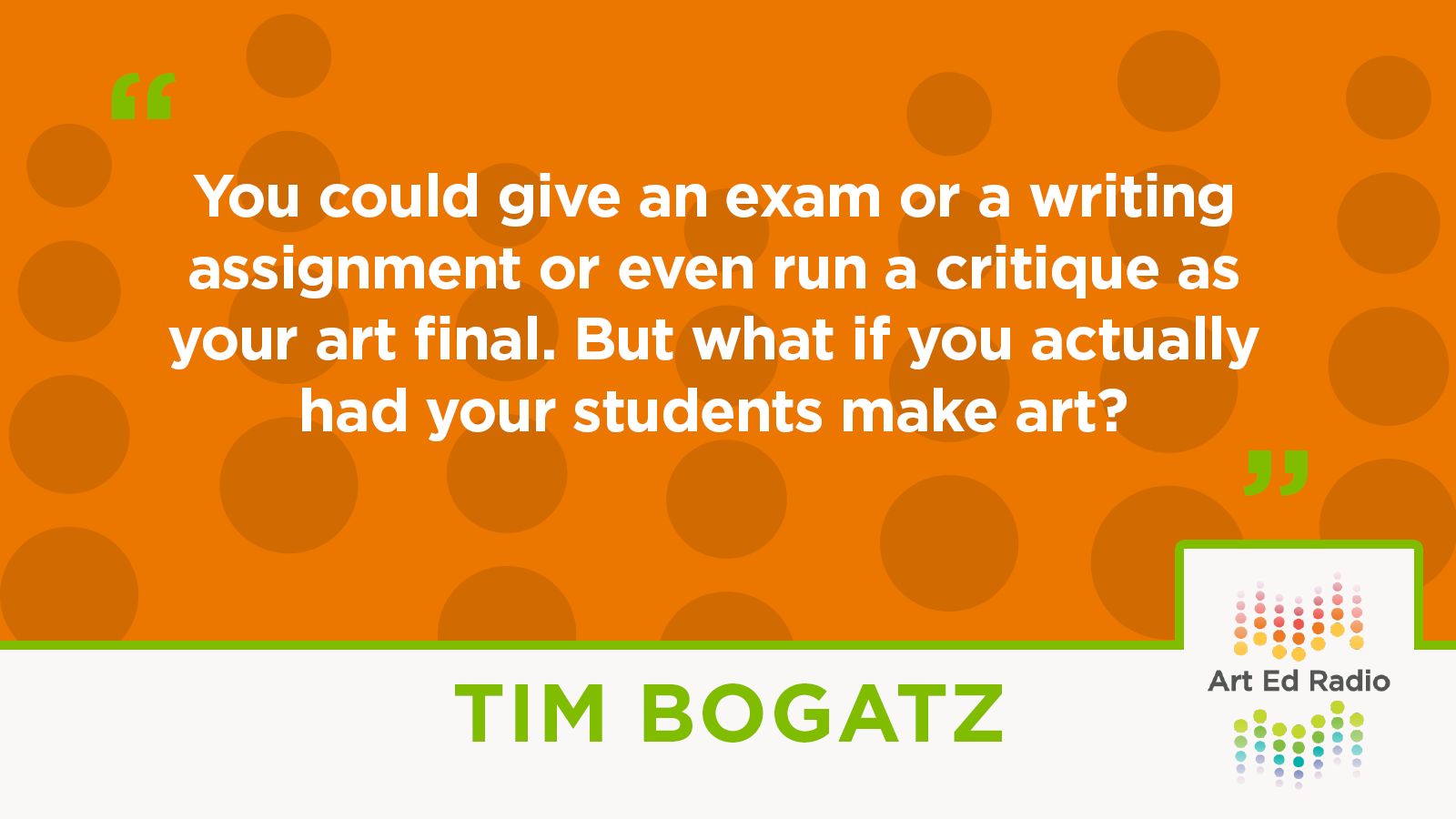
Transcript
Tim: Welcome to Art Ed Radio, the podcast for art teachers. This show is produced by the Art of Education University, and I’m your host, Tim Bogatz.
Now, before we get started on things today, I thought I should give you a couple of updates on shows from previous weeks. I’ve gotten a few requests from listeners to know what happened with X, or what happened with Y, from previous weeks. So I will do my best to update you quickly on some of the things we’ve been talking about over the past month or so. So, the biggest and probably coolest idea, a few weeks ago, Lindsay Moss was on here to talk about her Drive-Thru Art Show, her outdoor, COVID-safe, socially distant get together, where families could drive through, listen on their car radios, listen to the kids talk about their artworks. And, they could also drive through and view the collaborative displays that came together.
And, you’ll be happy to know that was a rousing success. Lindsay told me that she was originally worried about the work because it wasn’t the same quality that families were used to seeing, wasn’t the same quality as most years. And, she also told me that no one cared about that. And, she thought the kids might feel even more proud this year of the things that they’ve created, the things they’ve done, because art this year was just a very cathartic experience, which honestly, we’re all living this, we all know this, this is what kids need, now more than ever. And so, she said that the kids loved everything that they made, and that just gave her the best feeling.
The turnout was amazing. She had an incredibly successful show, and I think most importantly, Lindsay survived, which honestly, is an accomplishment for everyone who has gotten through the year. So, good for you. And, I will just say, I am in awe of anyone who was able to put on an art show as well this year. I think with everything that we’ve gone through, that is an amazing feat, and kudos to you.
Secondly, Eric Scott was on a couple of weeks ago talking about visual journaling. We had an awesome conversation, a long conversation, and he is continuing to do the live stream every day with his visual journal, which is great to follow along with or catch up on later. I think he still has a couple of workshops coming up that you can still sign up for so you can check out what he’s doing, and visit his website if you want to see everything that’s going on there.
Now, you have also heard me talking over the past month or so about our new podcast, The Art of SEL. It’s an eight-episode mini series, all about social and emotional learning. It has been incredibly popular. It’s been really well received. So, if you have been curious about the show, about checking out a podcast on social and emotional learning, I would encourage you to check it out. The first two episodes are already out. You can go subscribe. You obviously know how to find a podcast if you’re listening to this. So, just look up The Art of SEL wherever you get this one. Like I said, they are going to be eight episodes. The first one came out last week, all about the importance of social and emotional learning, and the role that art teachers can play. And then yesterday, the second episode was released, and it’s about the topic of self-awareness, features a great conversation about a powerful project called Why You Matter, so go give that a listen.
All right. Now, with all of that being said, with all of those updates, we need to chat about today’s topic, which what do finals look like in the art room? We talked last week to Jessica Provo about the awesome favorite teacher portrait that she does with her kids, which is amazing, and I absolutely am in love with that idea. I think that it’s so cool, and she and her colleagues are doing some great things with that. And today I want to share my idea, which pales in comparison. But, it’s I think still worthwhile, and I think can be helpful for a lot of people. So, basically instead of a long, involved project that takes a lot of time and a lot of planning, we do a short project that shows what my kids know, and what they can do when it comes to creating art, which should be the entire goal of our final assessment, I think. And, so if you are looking for something to squeeze in, in your last week of school and don’t have time for a big involved project, maybe this can help you.
I wrote an article a long time ago, long time ago, about everything that I do here, but I want to explain it a little bit more in-depth, so you can, like I said, if this works for you, then you can go for it. But basically, we have a long period of time in which kids can take their final. And, I ask them to create an artwork from beginning to end in that one long class period. So, back in 2012, 2013 maybe, my school started that final schedule with each class meeting for 95 minutes for what they call a culminating activity. And that’s where all of the good teachers go, “Oh, yeah. Yeah. Cool,” so this will be just like the final that I always give, maybe a little more time so kids can explain a little bit more about all the things they learned. And all the bad teachers are like, “Culminating activity? You mean I can’t show a movie on the last day?” and that’s okay.
So, my apologies if you always show a movie on the last day and you’re offended by that. But, I think it’s a good opportunity to think about what a culminating activity can look like. How can kids show what they’ve learned throughout the semester? And I think a great way to do that is just show what they can do making art. I’ve done written exams previously, or a mix of writing and drawing. I’ve done straight writing activities. But, I eventually just came to the realization that in an art class, we should probably be doing art with our final.
So, let me tell you about I guess the process that I have used with a couple of preparation days, and that 95-minute block of time for students to create the artwork from beginning to end. And, it doesn’t have to be 95 minutes, you can adapt this to whatever schedule you have, and it can work for you. So, like I said, though, let me just talk you through the steps.
So, Step 1 in this art making activity is to just start with a theme. And, we can talk a little bit more specifically about what themes work later. But just having a theme for kids to get going with. You can decide on it, you can let your kids decide on the theme, whatever approach you take is going to be just fine, but just a theme to direct your kids. Not necessarily saying, “Hey, just make whatever you want in these 95 minutes.” Giving them an idea to start their brainstorming, narrow their focus, give them a little bit of a constraint to figure out what they can do frames things for them and really helps them know where to start and know how to approach it.
And then, I like to just spend some time… This would be Step 2. Step 2 would be to spend some time brainstorming and talking out ideas and possibilities. You have your theme, so let’s talk about what ideas go along with that theme. What are the possibilities for art making that deal with that theme? It’s a great time to do some collaborative stuff, to get kids talking, to share ideas, to discuss what might work well, what might be difficult. And, if you work with middle schoolers and you work with high schoolers, you know that they don’t always think through their ideas or have the best sense of what might be possible or what might be successful. So, I think having them share those ideas out loud and just having someone hear them out can be really helpful for them to, like I said, again, just focus their attention, narrow down what’s possible, and giving them a clearer idea of what they’re going for.
Step 3. After they have some ideas, have them create some sketches and see what’s going to work for them. I’m always a fan of thumbnail sketches, I’m always a fan of putting a bunch of ideas on paper. So, one thing that works for me is, I’ll just have kids take a sheet of paper in their sketchbook, in their visual journal, or just whatever paper is lying around, and divide the page into nine different sections, two lines down, two lines across. And then, in one of those sections, list their eight best ideas, and whatever may go with the theme. So, if animals is your theme, list eight animals that might work, for example. And then, do a sketch for each of the eight in the remaining sections of the paper. So you have eight different quick sketches and they can see what might work. And, after they have those ideas listed out, after they have some sketches made, it’s a good time for them to talk to their classmates again, see what sketches are worthwhile, see what maybe needs more development, and what ideas are going to be worth pursuing.
Then, after they have a sketch or a couple of sketches that they really like, they’ve decided on what they want to do, they have a vision on what’s worth pursuing, Step 4 is going to be to move on to create some sketches with specificity. So again, we’re trying to find the best idea, find the best sketch from the best drawing they want to do, and see what needs to be worked on. Spend some time thinking about composition, spend some time thinking about color schemes, about what needs more detail, what needs more attention.
And, a big one is, what medium is going to work the best for them? And I think that’s a really good way for kids to demonstrate what they’ve learned is just by picking a medium that’s not only they can work well with, that they enjoy, but they can show some aptitude with. Because, if you force kids into using graphite, for example, that works really well for the kids who are really skilled with graphite. But, it really handcuffs kids who maybe aren’t quite as good, and you’re not going to be able to see their full vision come through because they’re a little too worried about the technical parts of that. And so, if you open it up and say, “You can paint, you can use oil pastels, you can do this digital if you want.”
That allows kids to relax, first of all, because they are using a medium that they’re confident with, that they feel comfortable working with, and they can really focus on their idea, showing off their artwork, without having to worry quite as much about the technical side of it, because they’re in that comfort zone. And, just being able to demonstrate, “This is the medium I like, this is why I like it, and this is how I use it, that’s great for assessment. It shows a lot about what they’ve learned, the skills they’ve developed, and what they can do. And so, I love letting kids choose whatever medium they think is going to work the best.
All right. And then, Step 5. Last day before the final, not sure how many days you’ve spent sketching and re-sketching and planning and drawing out ideas. Let the kids get all of their materials prepped: paper, paint, palettes, pencils, pastels. Wow, that is some quality alliteration, Tim. Just all of the materials that may or may not start with P. Even if they need their photo editing program, whatever. Get all of that stuff together so it’s ready to go, so they can come in for the 95 minutes or however long you have, and just get working immediately.
If they’re doing a small, detailed pencil drawing and their paper’s going to be six by nine, awesome, cut that 6 x 9 paper. If they’re going to do huge strokes with chalk pastels and blend things everywhere, and they want to pay for that 16 x 20, get the 16 x 20 paper ready, get those pastels out, and get them everything they need so they can come out, grab their materials and just start working.
And then, Step 6, the pressure is on. It’s time for them to come in and create their final. They have that time constraint, and within whatever that time may be, it’s a chance for them to create a meaningful artwork from beginning to end, and that is the final. And so during that time, you’re going to have kids drawing, and painting, maybe sculpting, maybe taking and editing photos. All of those things are worthwhile. All of those things can be a good way for kids to demonstrate what they’ve learned.
The first time I ever did this, I was really nervous for the kids who were shooting photos and editing them. But then once I got started, I realized there was no need for me to be nervous. It was more of a me thing because I’m really nervous with Photoshop because I’m slow, I’m not good. But, these guys are naturals. They are so much better at that than I am, and they just zoom through everything with taking photos, uploading them, editing them, and printing them. They had no issues whatsoever.
So, we had some really great ideas. We had what I think are really great results, consistently, especially considering the time constraints. And I think part of that is letting kids use the materials that they are comfortable with, and part of that is just putting a lot of time and thought into the process, into creating those sketches, figuring out what the composition is going to be, what the color scheme is going to be, and just having everything ready to go beforehand. And, that’s a good lesson that kids can take with them. They can really see that the process can be super helpful. The more planning you do, the easier the final work is going to come.
So, I guess the question is, “What did these look like?” And, I think it’s a good time to circle back around to the idea of the themes that I mentioned earlier. So, one theme that I have always liked to do is comfort. And so, I end up seeing a lot of comfortable places as a recurring theme, beds specifically, but just spots where kids feel comfortable, where they feel like they can relax, where they feel like they can be themselves, finding some way to illustrate those. Comfort food is always pretty popular, and so are objects that bring us comfort. And so, a lot of ideas were developed about, like I said, comfort in solitude, but also comfort in our vices and the things that we love. And so, it’s really good to see the ideas develop and come into fruition, and see the different ideas that the kids can come with. Because you have 30 kids and 30 experiences, and 30 different approaches to the same theme, which I think is really neat.
A couple of other themes that worked really well for me, music was a really popular one. Kids always dive into that, and so we get a lot of instruments being shown, like a violin, just a microphone, a piano with important objects placed on it, or sheet music that morphs into other objects. Just a lot of really good ideas. You know your students, you know how much they love music, and that’s an idea that always has a lot of ideas that spring from that theme, a lot of different things come to fruition there.
Another unique one that I think was really cool was the theme was old antique or vintage. And, that takes a little more research, a little more thinking from the kids, but we’ve gotten some great things. I see a lot of typewriters or old technology. Kids love doing old cars, or any type of old transportation. And then, old architecture is always really, really popular, and you can do some cool things with that. So, I really enjoy that one.
Other simple ones that I think work well, things like nature or animals, textures, heights. Just things that you imagine get a picture in your head that can be immediately represented by a single object, I think those always work well.
And there are other ideas that are maybe a little bit more elaborate, like other themes. I’m thinking of things like power or identity is a big one, beauty, community. Those still work, but I think they’re better served as a bigger project that they have longer for. Because, with the time constraints, it’s tough to illustrate those bigger, more meaningful words. What I think we can be going for is something that can be thought about and shown in more simple ways. You don’t show identity easily or quickly with just a couple of objects. And so I think they, a thought where you can show a typewriter, that’s going to be a lot easier, it’s going to work a lot better with the time constraints, and kids are going to be more successful with just what we’re talking about here.
So, I like those one-word themes. They’re about as open as you can get. And you can let kids develop a variety of ideas and take a variety of approaches that work for them.
Okay. I guess one last thought I wanted to share with us though, is just the one big drawback for this type of final is, when you go through this process, it doesn’t leave a lot of time to give good feedback. I felt like I was hamstrung, I feel like there’s an inability of the teacher to give meaningful feedback after the fact. Now you obviously are talking to kids, working with kids, giving them a lot of feedback throughout the process. You can give a lot of criticism during the brainstorming phases, and you can critique sketches, and you can have those conversations during the creation of the project, but there’s no way to give a worthwhile final critique. It’s more of like, “Turn your project in, I’ll grade it, and you can pick it up after school, maybe, and maybe I’ll see your next semester, maybe I won’t, whatever the case may be.” And it makes it really tough to have a big discussion.
So I’d always tell kids, “Hey, I’m open if you want to talk in-depth about your final project,” when I thought about it. But surprisingly after school’s out, nobody took me up on that offer. No, kids rarely want to talk about it. They want to be done and get out of there, and that’s okay. I have not figured out how to solve that problem just yet, but I feel like we’ve done enough throughout the year, and we’ve done enough throughout just the process of creating that final, that hopefully it works for the kids. Hopefully, they get enough feedback to make the learning meaningful, to make the learning worthwhile. So that’s, I guess just one kind of final drawback, but I think overall, this idea is a really, really good one, so I wanted to share that with you.
I hope this explainer has given you a chance to think about it, see if it works for you. And, if you think it might, if you’re trying to squeeze in a final at the end of this year, this might be a good way to go about it. So if it works for you, give it a try. Good luck, and good luck finishing out the rest of your school year.
Art Ed Radio is produced by the Art of Education University, with audio engineering by Michael Crocker. Thank you for listening. And one last reminder here, to go check out The Art of SEL Podcast with Jonathan Jurewicz, an amazing eight episodes. You only get the first two right now, but there will be eight, all about social, emotional learning in the art room. Powerful ideas, great podcast to listen to, I think you’ll really enjoy it, so give it a chance.
Magazine articles and podcasts are opinions of professional education contributors and do not necessarily represent the position of the Art of Education University (AOEU) or its academic offerings. Contributors use terms in the way they are most often talked about in the scope of their educational experiences.
